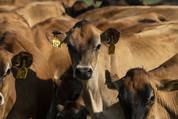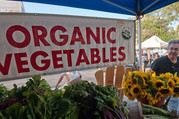|
Jan. 17
|
All offices closed for Martin Luther King Jr. Day
|
|
Jan. 18
|
Acreage Reporting Deadline for Apples, Grapes & Peaches
|
|
Jan. 27
|
Supplemental Dairy Marin Coverage Program Webinar
|
|
Feb. 1
|
NAP Coverage Deadline for beets, burdock, chicory, greens, herbs, leeks, lettuce, onions, radicchio, radishes, scallions, shallots, and turnips
|
|
Feb. 4
|
Organic and Transitional Education and Certification Program (OTECP) Deadline
|
|
Feb. 18
|
Dairy Margin Coverage Deadline for 2022 Program Year and Supplemental Coverage
|
|
Feb. 25
|
Spot Market Hog Pandemic Program Deadline
|
|
Ongoing
|
Conservation Reserve Program (CRP) - Continuous Enrollment
|

The Biden Administration recently appointed Jim Barber as the new State Executive Director (SED) for the USDA New York Farm Service Agency (FSA). Barber joined the New York FSA team on Dec. 13, 2021.
“Individuals selected to serve as FSA State Executive Directors are incredible public servants who have a proven track record when it comes to their commitment to advance their states and communities,” said Agriculture Secretary Tom Vilsack. “Each will serve on the frontlines, carrying out USDA’s mission at the state level and ensuring the voice of each and every USDA customer is heard. We are fortunate to have each of these talented individuals at this critical time for farmers and producers and rural communities across America.”
Barber returns to the Department as the Farm Service Agency’s State Executive Director for New York after serving in the same role for eight years in the Obama administration. During his previous tenure as head of the New York FSA, Barber made improvements in the Farm Loan program by dramatically increasing efficiency throughout the program. He took great efforts to reach out to minority farmers and involve underserved communities in FSA programs, including setting up urban farms in New York City and improving outreach to Native American nations across the state. Barber is a proud fifth generation family farm operator on his family’s 500-acre, highly diversified, vegetable farm and greenhouse operation and is a graduate of Cornell University.
As SED, Barber will be responsible for overseeing the delivery of FSA programs to agricultural producers in New York. These commodity, conservation, credit, and disaster assistance programs ensure a safe, affordable, abundant, and nutritious food, fiber, and fuel supply for consumers.
|

The U.S. Department of Agriculture (USDA) Farm Service Agency (FSA) in New York state will present a webinar on the Dairy Margin Coverage (DMC) program, and Supplemental DMC program on Thursday, January 27, at 10 a.m.
Dairy Margin Coverage (DMC) is a voluntary program that provides dairy operations with risk management coverage that will pay producers when the difference (the margin) between the national price of milk and the average cost of feed falls below a certain level selected by the program participants.
Supplemental DMC will provide $580 million to better help small- and mid-sized dairy operations that have increased production over the years but were not able to enroll the additional production. Now, they will be able to retroactively receive payments for that supplemental production. Additionally, FSA updated how feed costs are calculated, which will make the program more reflective of actual dairy producer expenses. Eligible dairy operations with less than 5 million pounds of established production history may enroll supplemental pounds based upon a formula using 2019 actual milk marketings, which will result in additional payments. Producers will be required to provide FSA with their 2019 Milk Marketing Statement. FSA will accept applications for both DMC and Supplemental DMC until February 18.
New York FSA will present a webinar on these programs and how to sign-up. The webinar is free however pre-registration is required. The webinar will be recorded, and a link will be sent to all that register. Please register here: https://supplemental_dmc.eventbrite.com
If you need an accommodation to participate in this webinar, please contact Lynnette Wright at (315) 477-6309, or by e-mail at lynnette.wright@usda.gov, by January 26. You may also contact Federal Relay Service at 1-800-877-8339.
|

The USDA Farm Service Agency’s (FSA) Direct Farm Ownership loans can help farmers and ranchers become owner-operators of family farms, improve and expand current operations, increase agricultural productivity, and assist with land tenure to save farmland for future generations.
There are three types of Direct Farm Ownership Loans: regular, down payment and joint financing. FSA also offers a Direct Farm Ownership Microloan option for smaller financial needs up to $50,000.
Joint financing allows FSA to provide more farmers and ranchers with access to capital. FSA lends up to 50 percent of the total amount financed. A commercial lender, a State program or the seller of the property being purchased, provides the balance of loan funds, with or without an FSA guarantee. The maximum loan amount for a joint financing loan is $600,000, and the repayment period for the loan is up to 40 years.
The operation must be an eligible farm enterprise. Farm Ownership loan funds cannot be used to finance nonfarm enterprises and all applicants must be able to meet general eligibility requirements. Loan applicants are also required to have participated in the business operations of a farm or ranch for at least three years out of the 10 years prior to the date the application is submitted. The applicant must show documentation that their participation in the business operation of the farm or ranch was not solely as a laborer.
For more information about farm loans, contact your local County USDA Service Center or visit fsa.usda.gov.
|

The U.S. Department of Agriculture (USDA) has extended the deadline for agricultural producers who are certified organic, or transitioning to organic, to apply for the Organic and Transitional Education and Certification Program (OTECP). This program provides pandemic assistance to cover certification and education expenses. The deadline to apply for 2020 and 2021 eligible expenses is now Feb. 4, 2022, rather than the original deadline of Jan. 7, 2022.
Certified operations and transitional operations may apply for OTECP for eligible expenses paid during the 2020, 2021 and 2022 fiscal years. Signup for the 2022 fiscal year will be announced at a later date.
For each year, OTECP covers 25% of a certified operation’s eligible certification expenses, up to $250 per certification category (crop, livestock, wild crop, handling and State Organic Program fee). This includes application fees, inspection fees, USDA organic certification costs, state organic program fees and more.
Crop and livestock operations transitioning to organic production may be eligible for 75% of a transitional operation’s eligible expenses, up to $750, for each year. This includes fees charged by a certifying agent or consultant for pre-certification inspections and development of an organic system plan.
For both certified operations and transitional operations, OTECP covers 75% of the registration fees, up to $200, per year, for educational events that include content related to organic production and handling in order to assist operations in increasing their knowledge of production and marketing practices that can improve their operations, increase resilience and expand available marketing opportunities. Additionally, both certified and transitional operations may be eligible for 75% of the expense of soil testing required under the National Organic Program (NOP) to document micronutrient deficiency, not to exceed $100 per year.
Producers apply through their local FSA office and can also obtain one-on-one support with applications by calling 877-508-8364. The program application and additional information can be found at farmers.gov/otecp.
Additional Organic Support
OTECP builds upon USDA’s Organic Certification Cost Share Program (OCCSP) which provides cost share assistance of 50%, up to a maximum of $500 per scope, to producers and handlers of agricultural products who are obtaining or renewing their certification under the NOP. Although the application period for OCCSP ended Nov. 1, 2021, FSA will consider late-filed applications for those operations who still wish to apply.
Meanwhile, USDA’s Risk Management Agency (RMA) recently made improvements to Whole-Farm Revenue Protection to make it more flexible and accessible to organic producers.
To learn more about USDA’s broader assistance for organic producers, visit usda.gov/organic.
|

The Farm Service Agency’s (FSA) Farm Storage Facility Loan (FSFL) program provides low-interest financing to help you build or upgrade storage facilities and to purchase portable (new or used) structures, equipment and storage and handling trucks.
Eligible commodities include corn, grain sorghum, rice, soybeans, oats, peanuts, wheat, barley, minor oilseeds harvested as whole grain, pulse crops (lentils, chickpeas and dry peas), hay, honey, renewable biomass, fruits, nuts and vegetables for cold storage facilities, floriculture, hops, maple sap & syrup, rye, milk, cheese, butter, yogurt, meat and poultry (unprocessed), eggs, and aquaculture (excluding systems that maintain live animals through uptake and discharge of water). Qualified facilities include grain bins, hay barns and cold storage facilities for eligible commodities.
Loans up to $50,000 can be secured by a promissory note/security agreement, loans between $50,000 and $100,000 may require additional security, and loans exceeding $100,000 require additional security.
You do not need to demonstrate the lack of commercial credit availability to apply. The loans are designed to assist a diverse range of farming operations, including small and mid-sized businesses, new farmers, operations supplying local food and farmers markets, non-traditional farm products, and underserved producers.
For more information, contact your local USDA Service Center or visit fsa.usda.gov/pricesupport.
|

The Farm Service Agency’s (FSA) Noninsured Crop Disaster Assistance Program (NAP) helps you manage risk through coverage for both crop losses and crop planting that was prevented due to natural disasters. The eligible or “noninsured” crops include agricultural commodities not covered by federal crop insurance.
You must be enrolled in the program and have purchased coverage for the eligible crop in the crop year in which the loss incurred to receive program benefits following a qualifying natural disaster.
NAP Buy-Up Coverage Option
NAP offers higher levels of coverage, from 50 to 65 percent of expected production in 5 percent increments, at 100 percent of the average market price. Buy-up levels of NAP coverage are available if the producer can show at least one year of previously successfully growing the crop for which coverage is being requested.
Producers of organics and crops marketed directly to consumers also may exercise the “buy-up” option to obtain NAP coverage of 100 percent of the average market price at the coverage levels of between 50 and 65 percent of expected production.
NAP basic coverage is available at 55 percent of the average market price for crop losses that exceed 50 percent of expected production.
Buy-up coverage is not available for crops intended for grazing.
NAP Service Fees
For all coverage levels, the NAP service fee is the lesser of $325 per crop or $825 per producer per county, not to exceed a total of $1,950 for a producer with farming interests in multiple counties.
NAP Enhancements for Qualified Military Veterans
Qualified veteran farmers or ranchers are eligible for a service fee waiver and premium reduction, if the NAP applicant meets certain eligibility criteria.
Beginning, limited resource and targeted underserved farmers or ranchers remain eligible for a waiver of NAP service fees and premium reduction when they file form CCC-860, “Socially Disadvantaged, Limited Resource and Beginning Farmer or Rancher Certification.”
For NAP application, eligibility and related program information, contact your local County USDA Service Center or visit fsa.usda.gov/nap.
|
FSA offers direct farm ownership and direct farm operating loans to producers who want to establish, maintain, or strengthen their farm or ranch. Direct loans are processed, approved and serviced by FSA loan officers.
Direct farm operating loans can be used to purchase livestock and feed, farm equipment, fuel, farm chemicals, insurance, and other costs including family living expenses. Operating loans can also be used to finance minor improvements or repairs to buildings and to refinance some farm-related debts, excluding real estate.
Direct farm ownership loans can be used to purchase farmland, enlarge an existing farm, construct and repair buildings, and to make farm improvements.
The maximum loan amount for direct farm ownership loans is $600,000 and the maximum loan amount for direct operating loans is $400,000 and a down payment is not required. Repayment terms vary depending on the type of loan, collateral and the producer's ability to repay the loan. Operating loans are normally repaid within seven years and farm ownership loans are not to exceed 40 years.
Please contact your local FSA office for more information or to apply for a direct farm ownership or operating loan.

In response to feedback received from the producers, the U.S. Department of Agriculture (USDA) is improving crop insurance for hemp. USDA’s Risk Management Agency (RMA) is strengthening the hemp crop insurance policy by adding flexibilities around how producers work with processors as well as improving consistency with the most recent USDA hemp regulation.
RMA revised the policy to add flexibility to the insurability requirements for hemp under contract. Producers are no longer required to deliver hemp without economic value for insurability. However, contracts between producers and processors may still include delivery requirements. Additionally, RMA clarified how the amount of insurable acreage is determined if the processor contract specifies both an acreage and a production amount. This change was made in the policy to ensure producers know how their insurable acreage is determined for those contracts.
Other Updates
To ensure consistency across USDA, RMA updated references to regulations, including the Agriculture Marketing Service final rule, which took effect March 22, 2021.
Additionally, RMA added a new requirement for producers who grow direct-seeded hemp, or hemp grown from seeds planted in the ground. Before insurance attaches, producers must have acreage inspected and must have a minimum of 1,200 live plants per acre. This requirement was added to align direct-seeded hemp with the common farming practice for transplanted Cannabidiol (CBD) of transplanting at least 1,200 live plants per acre.
About the Hemp Policy
The hemp crop insurance policy provides Actual Production History (APH) coverage against loss of yield due to insurable causes of loss for hemp grown for fiber, grain, or CBD oil. The Farm Bill defines hemp as containing 0.3% or less tetrahydrocannabinol (THC) on a dry-weight basis. Hemp having THC above the federal statutory compliance level of 0.3% is an uninsurable or ineligible cause of loss and will result in the hemp production being ineligible for production history purposes.
The hemp crop insurance policy is available in certain counties within 25 states: Alabama, Arizona, Arkansas, California, Colorado, Illinois, Indiana, Kansas, Kentucky, Maine, Michigan, Minnesota, Montana, Nevada, New Mexico, New York, North Carolina, North Dakota, Oklahoma, Oregon, Pennsylvania, Tennessee, Texas, Virginia, and Wisconsin.
In 2021, hemp producers insured 12,189 acres and 59 policies to protect $10.9 million in liabilities.
Other Coverage for Hemp
In addition to the APH crop insurance policy, coverage for hemp is available through Whole-Farm Revenue Protection, the Nursery crop insurance program, and the Nursery Value Select pilot crop insurance program. Additionally, the Noninsured Crop Disaster Assistance Program coverage, offered through USDA’s Farm Service Agency (FSA), protects against losses associated with lower yields, destroyed crops or prevented planting where no permanent federal crop insurance program is available.
The 2018 Farm Bill reclassified and legalized the regulated production of industrial hemp as an agricultural commodity (it is now legal to grow industrial hemp). Hemp producers can learn more at farmers.gov/hemp.
Crop insurance is sold and delivered solely through private crop insurance agents. A list of crop insurance agents is available at all USDA Service Centers and online at the RMA Agent Locator. Learn more about crop insurance and the modern farm safety net at www.rma.usda.gov.
|
FSA is cleaning up our producer record database and needs your help. Please report any changes of address, zip code, phone number, email address or an incorrect name or business name on file to our office. You should also report changes in your farm operation, like the addition of a farm by lease or purchase. You should also report any changes to your operation in which you reorganize to form a Trust, LLC or other legal entity.
FSA and NRCS program participants are required to promptly report changes in their farming operation to the County Committee in writing and to update their Farm Operating Plan on form CCC-902.
To update your records, contact your local County USDA Service Center.
If you received a payment under the Wildfires and Hurricanes Indemnity Program+ (WHIP+) or the Quality Loss Adjustment Program (QLA) for crop production and/or quality losses occurring in 2018, 2019, or 2020 crop years, you are required to meet linkage requirements by obtaining federal crop insurance or Non-Insured Crop Disaster Assistance Program (NAP) coverage at the 60/100 level, or higher, for both the 2022 and 2023 crop years.
When applying for WHIP+ or QLA, form FSA-895 (Crop Insurance and/or NAP Coverage Agreement) was submitted acknowledging the requirement to obtain federal crop insurance, if available, or NAP coverage if federal crop insurance is not available. The coverage requirement is applicable to the physical location county of the crop that received WHIP+ and/or QLA benefits.
Producers should not delay contacting their federal crop insurance agent or local county FSA Office to inquire about coverage options, as failure to obtain the applicable coverage by the sales/application closing date will result in the required refund of WHIP+ benefits received on the applicable crop, plus interest. You can determine if crops are eligible for federal crop insurance or NAP by visiting the RMA website.
To learn more about, contact your local USDA Service Center or visit fsa.usda.gov.
Producers with farmers.gov accounts can now access farm records and maps online, the latest self-service feature added to the U.S. Department of Agriculture (USDA) website.
You can quickly and easily access your land information in real time by desktop computer, tablet or phone. Capabilities include:
- View, print and export detailed farm records such as cropland, base acres, yields, CRP acres, land ownership details, and much more;
- View, print and export farm/tract maps that can be provided to lenders, chemical or fertilizer providers, and FSA for reporting acreage and crop insurance agents; and
- Export common land unit (field) boundaries as ESRI shapefiles.
The ability to access these records on demand without a visit to the service center saves you time and money.
Farmers.gov now includes the most popular functionalities from FSAFarm+, the FSA portal for producers, while providing enhanced functionality and an improved user experience. A new enhancement expands the scope of accessibility to include farmers and ranchers who are members of an entity, as well as people with a power of attorney form (FSA-211) on file with FSA.
Managing USDA Business Online
Using farmers.gov, producers, entities and those acting on their behalf can also:
- View, upload, download, and e-sign conservation documents.
- Request financial assistance, including submitting a program application.
- View and submit conservation requests.
- View technical references and submit questions.
- Access information on current and past conservation practices, plans and contracts.
- Report practice completion and request practice certification.
- View farm loan and interest information (producers only).
Future plans include adding the ability to import and view other shapefiles, such as precision agriculture planting boundaries.
To access your information, you’ll will need a USDA eAuth account to login to farmers.gov. After obtaining an eAuth account, producers should visit farmers.gov and sign into the site’s authenticated portal via the Sign In/Sign Up link at the top right of the website. Google Chrome, Mozilla Firefox or Microsoft Edge are the recommended browsers to access the feature.
In addition to the self-service features available by logging into farmers.gov, the website also has ample information on USDA programs, including pandemic assistance, farm loans, disaster assistance, conservation programs and crop insurance. Recently, USDA updated the navigation and organization of the site as well as added some new webpages, including “Get Involved,” “Common Forms,” and “Translations.” Learn more about these changes.
|